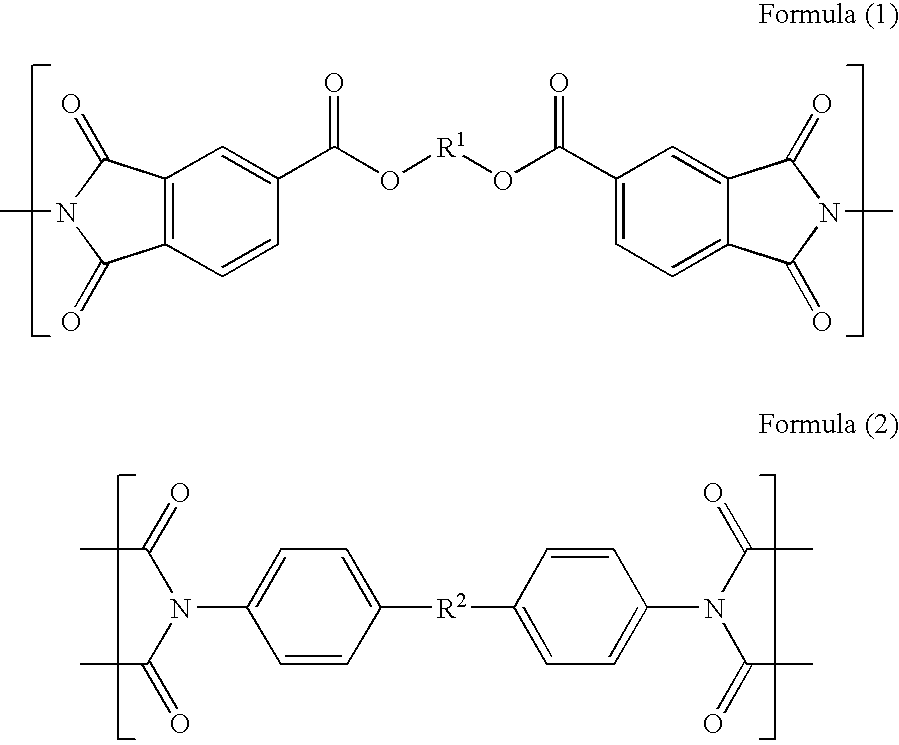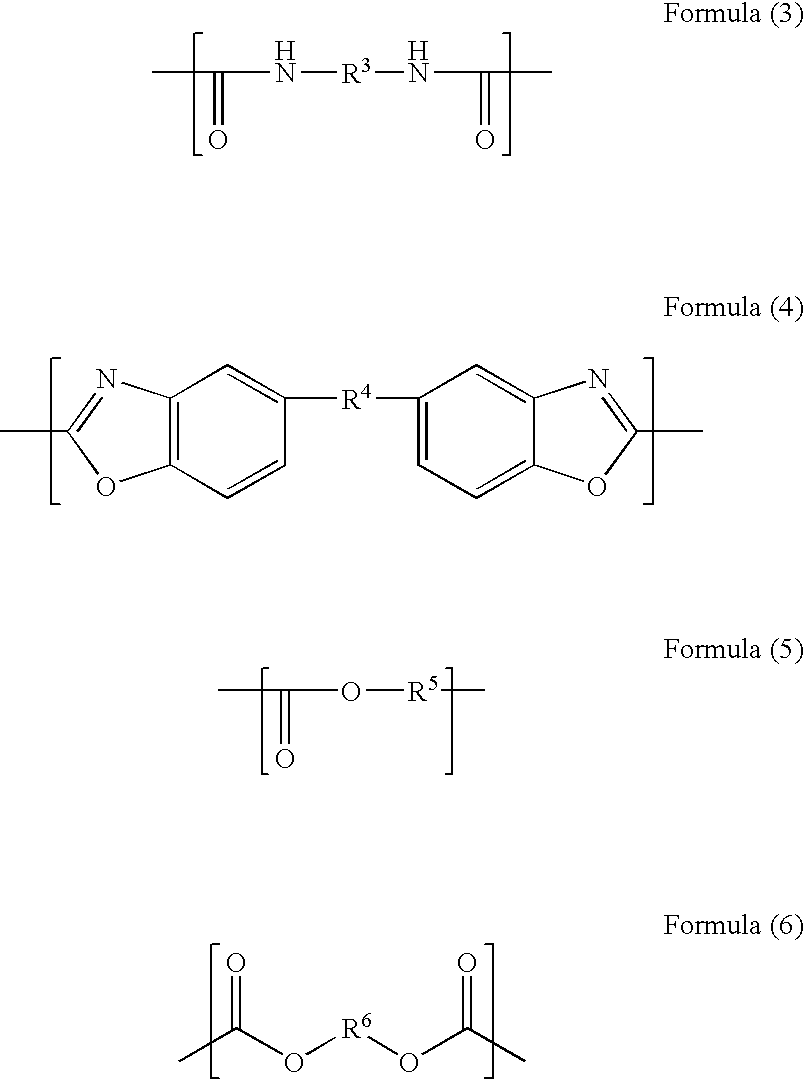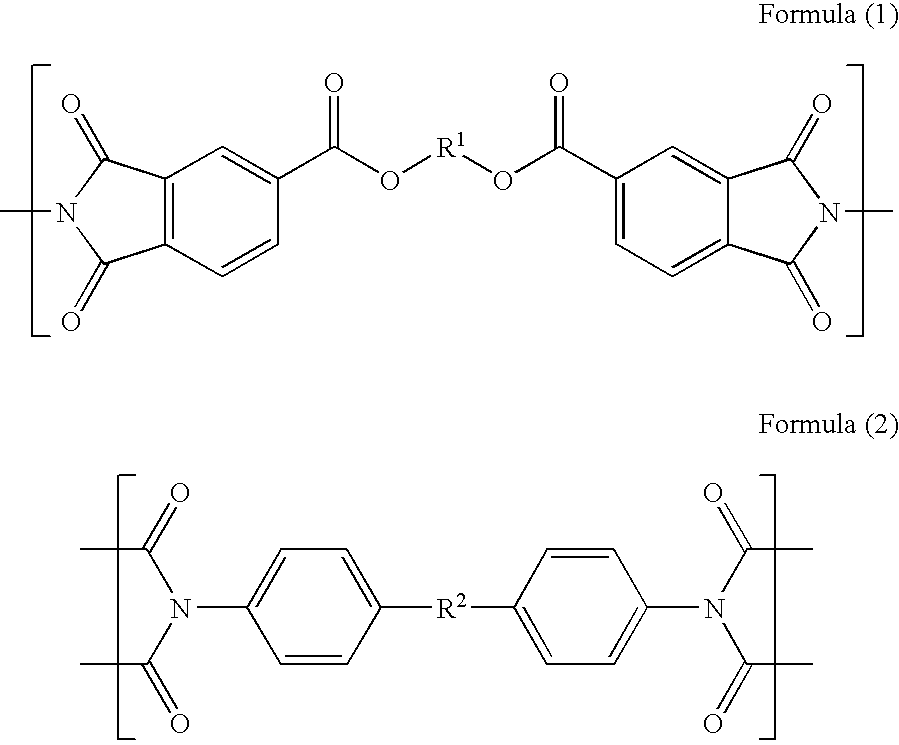Conductive film forming method and conductive material
a conductive film and forming method technology, applied in the direction of cable/conductor manufacturing, conductive layers on insulating supports, synthetic resin layered products, etc., can solve the problems of easy activation sites on the surface of polyimide base materials, occurrence of radicals, etc., to achieve superior adhesion to the surface of a base material, high heat resistance, and high endurance
- Summary
- Abstract
- Description
- Claims
- Application Information
AI Technical Summary
Benefits of technology
Problems solved by technology
Method used
Image
Examples
synthesis example 1
Synthesis of Polyimide Precursor 1 (Polyamic Acid 1)
[0142] 4,4′-diaminobenzophenone (28.7 mmol) was dissolved in N-methylpyrrolidone (30 ml) as a siamine compound in the presence of nitrogen and agitated at a room temperature for approximately 30 minutes.
[0143] p-phenylenebis(trimellitic acid monoester acid anhydride) (28.7 mmol) was added to the above solution at 0° C. and agitated for five hours. The reaction fluid was reprecipitated and a polyimide precursor 1 was obtained. The structure thereof was confirmed by means of 1H-NMR and FT-1R.
[0144] Synthesis examples 2 to 8 and Comparative synthesis example 1
[0145] Polyimide precursors 2 to 8 and comparative polyamic acid 1 (polyamic acids 2 to 9), each of which has a composition shown in the following Table 1, were synthesized in a similar manner as in the synthesis example 1.
TABLE 1Tetracarboxylic acid dianhydridecompoundDiamine compoundSynthesis Example 1p-phenylene-bis(trimellitic acid4,4′-diamino benzophenone: 28.7(Polyam...
example 1
Preparation of Surface Graft Polymer
[0147] The polyimide film 1 prepared according to the above-mentioned method was used as a substrate. A coating liquid having the following composition was coated on the substrate using a rod bar #18. A thickness of the film formed on the base material was 0.8 μm. Exposure was then carried out with respect to the obtained film using a 1.5 kW high-pressure mercury-vapor lamp for ten minutes. Thus obtained film was washed with water. Surface graft polymer was introduced on the entire surface of the base material thereby.
Composition of coating liquidPolymer including a polymerizable group0.25g(synthesized in the following method)Cyclohexanone8.0g
Method of Synthesizing Above-Described Polymer Having Polymerizable Group
[0148] 58.6 g of 2-hydroxyethylmetahacrylate was put in a three-neck flask having a 500 ml capacity and 250 ml of acetone was added thereto and then agitated. 39.2 g of pyridine and 0.1 g of p-methoxyphenol were further added there...
example 2
[0152] The metallic film 1 formed in Example 1 was further subjected to electroplating in an electroplating bath containing the following composition for 30 minutes, and thus a conductive film 2 was formed to provide a conductive material 2 of Example 2.
Composition of electroplating bathCopper sulfate38mgSulfuric acid95gChloric acid1mlBrightening agent (trade name KAPPA-GREEM PCM,3mlmanufactured by Meltex Inc.)Water500ml
PUM
| Property | Measurement | Unit |
|---|---|---|
| Substance count | aaaaa | aaaaa |
| Substance count | aaaaa | aaaaa |
| Substance count | aaaaa | aaaaa |
Abstract
Description
Claims
Application Information
 Login to View More
Login to View More - R&D
- Intellectual Property
- Life Sciences
- Materials
- Tech Scout
- Unparalleled Data Quality
- Higher Quality Content
- 60% Fewer Hallucinations
Browse by: Latest US Patents, China's latest patents, Technical Efficacy Thesaurus, Application Domain, Technology Topic, Popular Technical Reports.
© 2025 PatSnap. All rights reserved.Legal|Privacy policy|Modern Slavery Act Transparency Statement|Sitemap|About US| Contact US: help@patsnap.com



